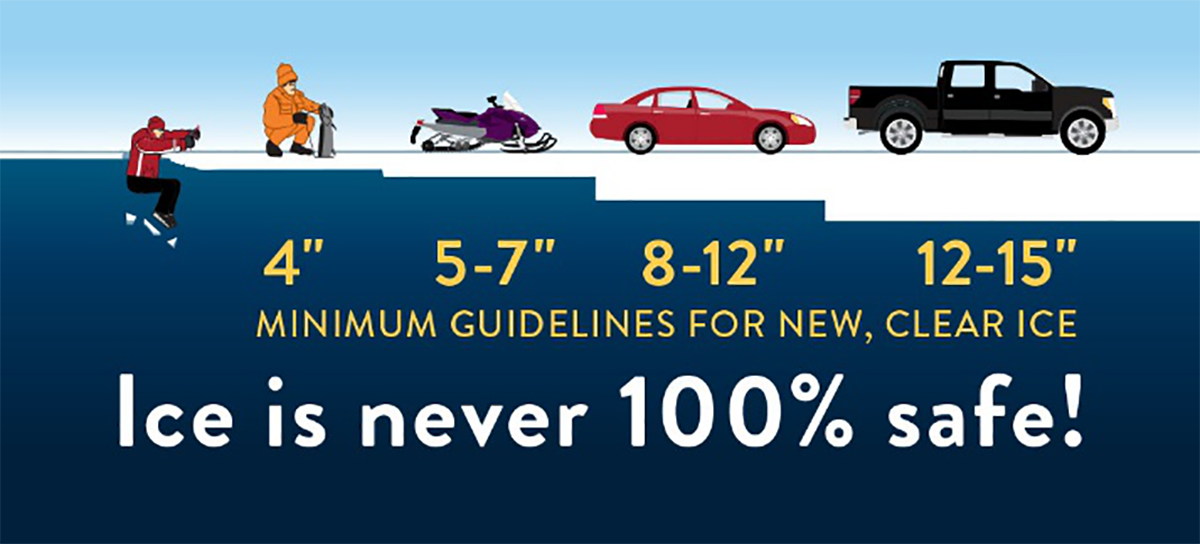1. With our on-again off-again winter, it’s uncertain when the Lake will develop "safe" ice. As such, this is a good time to remind winter lake users (and particularly children) about the need to exercise particular care and caution when venturing out on the ice when it does form. On the following page is some information on General Ice Thickness Guidelines. The MPOA website (wlmpoa.org) also has a video posted on how someone falling through the ice can perform a "self-rescue". https://youtu.be/QKpAzvXSldA
2. Winter lake users are also reminded of the presence of the rip-rap collars around O'Brien Shoals and Wickline Island, and that ice formation may have changed in those areas of the lake that had been dredged or have submerged springs.
3. Per MPOA regulations, ice fishing shanties must be removed from the Lake daily and must always display the name and address of the owner.
4. Any recreational vehicle on the ice must properly display a current MPOA winter decal. Automobiles, trucks and SUVs are strictly prohibited from entering upon Wonder Lake ice at any time. Anyone observed violating this regulation will be ticketed by the Wonder Lake Police Department with a fine of not less than $50.00 nor more than $500.00. 5. On Saturday, December 17, the Nippersink Watershed Association will conduct yet another workday, clearing invasive brush from a portion of the Merchant Creek stream corridor. This volunteer work is being done to help minimize the significant amounts of sediment that this parcel has delivered to Wonder Lake over the past decades. Meet at 7810 Wooded Shore Drive at 9 am. https://www.facebook.com/events/681505657026972?ref=newsfeed
6. The 2023 Illinois Lake Management Association (ILMA) Conference will be held on March 8th -11th at the Holiday Inn — Gurnee Convention Center, 6161 West Grand Ave in Gurnee. Having the conference in Lake County this year provides an opportunity for anyone interested in lakes, fisheries, water quality and other related issues to learn more and meet other like-minded folks. Registration information can be found at https://ilma-lakes.org/conference
General ice thickness guidelines
For new, clear ice only

UNDER 4" - STAY OFF
4" - Ice fishing or other activities on foot
5" - 7" - Snowmobile or ATV
8" - 12" - Car or small pickup (Not allowed on Wonder Lake)
12" - 15" - Medium truck (Not allowed on Wonder Lake)
Double the above thickness guidelines when traveling on white ice
White ice or "snow ice" is only about half as strong as new clear ice. Double the above thickness guidelines when traveling on white ice. Many factors other than thickness can cause ice to be unsafe.
Ice is never 100% safe
YOUR Safety is YOUR responsibility.
Check ice thickness at least every 150 feet. Checking ice thickness
Before heading out on ice: Temperature, snow cover, currents, springs and rough fish all affect the relative safety of ice. Ice is seldom the same thickness over a single body of water; it can be two feet thick in one place and one inch thick a few yards away. Check the ice at least every 150 feet.
Ways to check ice thickness:
Ice chisel An ice chisel is a metal rod with a sharp, flat blade welded onto one end. Drive the chisel into the ice, using a stabbing motion, to create a hole. Next, measure ice thickness with a tape measure.
Ice auger There are 3 different kinds of augers: hand, electric and gas. Hand augers are low cost, light weight and quiet. Electric augers are also quiet, but use less manual labor than a hand auger. Gas augers drill through ice the fastest, but are heavier, noisier and generally more costly than hand or electric models. After drilling a hole with the ice auger, measure ice thickness with a tape measure.
Cordless drill Using a cordless drill and a long, five-eighths inch wood auger bit, you can drill through eight inches of ice in less than 30 seconds. Most cordless drills that are at least 7.2 volts will work, but the type of bit is critical. You need a wood auger bit since they have a spiral called a "flute" around the shaft that metal drilling bits don't. The flutes pull the ice chips out of the hole and help keep it from getting stuck, much in the way a full-sized ice auger works. After drilling a hole, measure ice thickness with a measure tape. Dry the bit and give it a quick spray of silicone lubricant after each use to prevent rust.
Tape measure Use a tape measure to find ice’s true thickness. Put the tape measure into the hole and hook the bottom edge of ice before taking measurement. You can also use an ice fisherman's ice skimmer with inch markings on the handle in place of the tape measure. Don't judge ice thickness by how easily a chisel or drill breaks the surface. It happens so quickly that it’s easy to overestimate the thickness.
